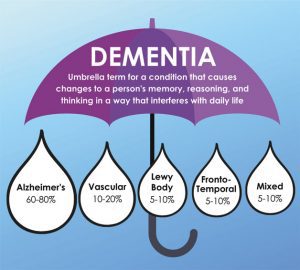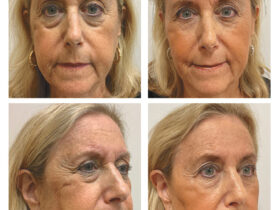By Amy Hoffmann Schenk, RN, BSN, MS Ed, Community Engagement Lead Neuropsychiatric Research Center of SW Florida

Wow, it is already April! How many of you remember the saying “April showers bring May flowers”? It was always important to have your umbrella handy. That is not necessarily true here in Florida, but I remember it distinctly growing up in NW Ohio. We needed a little pep talk to get through the gray, rainy and cloudy days of April with the promise that in May, our gardens would be blooming with the beauty of spring. Lilacs, lilies of the valley, the later blooming tulips all put on a gorgeous show in NW Ohio in May. After a long, cold and sometimes snowy winter, May’s flowers bring hope and happiness.
How do showers and flowers relate to this month’s article? We are going to explore in more detail the topic of dementia, and how it serves as an umbrella term for different types of dementia. The beauty of May’s flowers bring hope, just like research can bring hope to those who are living with Alzheimer’s disease.
Let’s look at the term “dementia” in a bit more detail. The national institute of Aging describes dementia as the loss of cognitive functioning, thinking remembering and reasoning to such an extent that is interferes with a person’s daily life and routine. Personality changes can also be part of the dementia experience. Dementia is not a specific disease, but more of a general term. The Alzheimer’s Association notes that dementia can be thought of as a general term for loss of memory, language, problem solving and other thinking abilities that interfere with daily life.
How does this connect to an umbrella? Dementia can be thought of as an “umbrella” term, where there are many different types of conditions that fall under the umbrella. There are likely over 100 different types of forms of dementia, and the most well known type is Alzheimer’s disease.
Here is a quick overview of the most common types of dementia from the National Institute
Alzheimer’s Disease
Alzheimer’s disease is the most common type of dementia with an estimated 60 – 80% of dementia being of the Alzheimer’s type. In Alzheimer’s disease abnormal deposits of proteins form amyloid plaques and tau tangles throughout the brain. Symptoms include repetitive questions, getting lost in familiar places and as the disease progresses, problems recognizing friends and family, along with impulsive behavior and significant communication issues. Alzheimer’s disease typically impacts individuals in their mid 60s and older, although there are instances of individuals with younger onset Alzheimer’s (occurring before age 65).
Frontotemporal Dementia
In Frontotemporal Dementia (FTD), abnormal amounts or forms of tau and TDP-43 proteins accumulate inside neurons in the frontal and temporal lobes of the brain. Two types of FTD are Primary Progressive Aphasia and the Behavioral variant. There can be difficulty planning and organizing, impulsive behavior, changes in personality as well as apathy. In primary progressive aphasia, there are language challenges such as issues with both verbal communication and understanding speech. This type of dementia is typically diagnosed at a younger age, between mid 40s and 65.
Lewy Body Dementia
In Lewy Body dementia, abnormal deposits of a protein called alpha-synuclein, also called “Lewy bodies” impact the brain’s chemical messengers. Difficulty concentrating, illogical ideas, visual hallucinations, sleep disorders, including vivid nightmares, and challenges with movement can be part of Lewy Body dementia, which typically impacts individuals over the age of 50.
Vascular Dementia
Vascular dementia is a result of damage to the blood vessels in the brain which disrupts blood flow. Symptoms can vary depending on the area of the brain impacted due to the impaired blood flow. Some common symptoms can include confusion, problems with concentration, difficulty with planning, organization and difficulty following directions and learning new information. Hallucinations may be a symptom along with poor judgment. This type of dementia is more common over the age of 65.
Mixed Dementia
Individuals may have more than one type of dementia. In those cases, the person is considered to have mixed dementia.
If you or someone you know is experiencing one or more of these symptoms, it is time to get checked out. We can help! Knowing your cognitive status via an easy and free memory screen is a service we provide to the community. In May, we have two entire days dedicated to conducting free memory screens, on Monday May 20th and Tuesday May 21st. See our ad to learn more. We also offer free memory screens at other times if that is more convenient. Just call us at 239 939 7777. Memories matter!
NPRC
Neuropsychiatric Research Center
239-939-7777 | nprc-swfl.com
14271 Metropolis Avenue., Fort Myers, FL
References:
Alzheimer’s Association | Alzheimer’s Disease & Dementia Help
Understanding Different Types of Dementia | National Institute on Aging (nih.gov)









